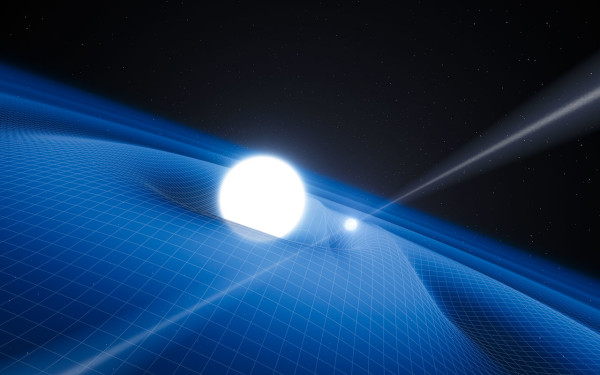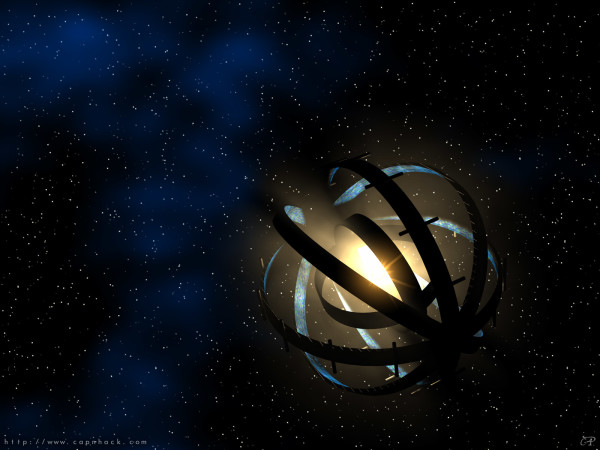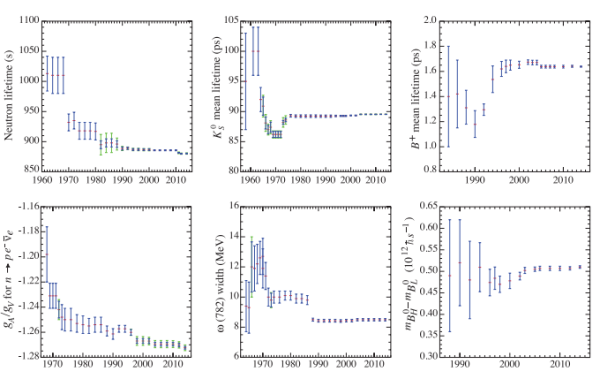“What might we learn from lines of research that are off the beaten track? They check accepted ideas, always a Good Thing, and there is the chance Nature has prepared yet another surprise for us.” -Jim Peebles
It's been a huge week here at Starts With A Bang, and one of our busiest on record. If you thought that Pluto's demotion was the biggest news about the outer Solar System, just wait until you get to the highlight of this week:
- How fast do gravitational waves travel? (for Ask Ethan),
- Physicists must accept that some things are unknowable,
- Have astronomers found alien megastructures after all? (No, probably not),
- The closest new stars to Earth are in a place you've never looked (for Mostly Mute Monday),
- Are cosmologists fooling themselves about the Big Bang, dark matter and more? (by Brian Koberlein),
- Not so fast: why there likely isn't a large planet beyond Pluto,
- How far away is the Universe's most distant galaxy, and
- Is the multiverse a scientific theory?
That's a lot! But not only is there plenty more on the way, including our next podcast (coming soon), a new week of articles coming (starting now), and the start of a special upcoming series on the future of astronomy. That said, let's get right into our comments of the week!
From Vincenzo Romano on the science of Powerball: "The best provable way not to [lose] at the lotteries is NOT TO BUY [TICKETS]. And you can even win!"
One of the more dastardly things about the American tax code is that if you lose at the lottery (or any gambling establishments), your losses are only tax deductible as subtracted from your winnings. But 100% of your winnings are tax deductible. So if you gamble and come out ahead $1000, you have to pay taxes on those $1000. If you gamble and come out down $1000, you had to pay tax on that income and don't recoup any of it for your losses. Unless you're someone who's okay with betting $1000 for a 50/50 shot of losing it all or winning $800, I strongly recommend against playing the lottery. By not losing, that's a win.
Image credit: simulations were performed at the National Center for Supercomputer Applications
by Andrey Kravtsov (The University of Chicago) and Anatoly Klypin (New Mexico State University).From Chris Mannering on structure formation: "You’ve not that I can see added any weight to your actual assertions which were situated roughly mid-century and involved evocation of sophisticated rich [structures] that were 40 years later empirically discovered being predicted in foundational big bang hypothesis. You also threw in the cosmic web, which I’m pretty sure is not explicable in terms of that, in principle. It need dark matter, and at the time that you place all the assertions, dark matter was still in its pre-infancy, in that it amounted to gravity anomalies observed in spirals only."
I let this slide for a week but let's go through it. When the Big Bang was first proposed back by Gamow and his collaborators back in the 1940s, it was pretty well understood that a hot, dense, homogeneous past would lead to a much cooler, sparser, and inhomogeneous present, where matter existed in clumps and in voids. It was understood that understanding exactly what structures would form and when were details that would need to be worked out, and that hadn't been worked out. The working out began, in earnest, in the 1960s by Peebles in the USA and by Zel'dovich in the USSR.
 Image credit: photos from the Tallinn Symposium on the Large Scale Structure of the Universe, with Peebles at left (next to Tremaine) and Zel'dovich third from left (next to Longair). From Einasto 2010, https://inspirehep.net/record/873314?ln=en.
Image credit: photos from the Tallinn Symposium on the Large Scale Structure of the Universe, with Peebles at left (next to Tremaine) and Zel'dovich third from left (next to Longair). From Einasto 2010, https://inspirehep.net/record/873314?ln=en.
By time the 1970s came along (the photos above are from the first IAU conference on structure formation, in 1977), these two were titans in the field of structure formation, having worked out the theoretical consequences of open, closed, and flat Universes with low or normal matter densities and modeled with and without hot, warm and cold dark matter. (Remember, Zwicky's work on dark matter existed in the 1930s, and when Rubin's work came to light, Peebles and Zel'dovich, leaders in the cosmology community, picked it up immediately.)
The data, however, wouldn't start to get good until the 1980s, when the first large surveys like the CFA survey and the PSCz survey -- precursors to things like 2dF, WISE and SDSS -- came along. For what it's worth, you totally get a cosmic web without dark matter; the major difference is in scale (and on small scales in particular), in BAO, in feedback from star formation and in density contrast. On the largest scales, though, you still get a cosmic web, and only the details differ.
 Image credit: user clif_hiker of LibraryThing; source from http://wellingtongrey.net/.
Image credit: user clif_hiker of LibraryThing; source from http://wellingtongrey.net/.
From Wow on sympathy for Richard Feynman's womanizing: "Please remember, Richard lost his wife who he loved and nearly lost his mind in grief. I’ve seen “womanising” be a coping mechanism: you don’t get hurt again if you don’t let someone get that close to you again."
Personally, it's not up to me to pass judgment on someone else's behavior, and it's not up to you to care about what I think, anyway. But beyond what I personally believe, there's a difference between being a womanizer in your personal life (which you may or may not approve of) and being a lecher or a harasser in your work environment and around your professional peers, juniors and seniors. If you want to be a womanizer, do it at your own risk. But if you want to subject your coworkers to your toxic behavior, you are way over the line. The AAS has defined harassment as "if it's unwanted, it's harassment," which means if you're out of line and you're told to knock it off, don't go and try it again on the next (or worse, the same) person. Knock off the bad behavior, which is exactly the thing that Geoff Marcy wouldn't do.
 Image credit: ESO/L. Calçada, of a pulsar orbiting a binary companion and the gravitational waves (or ripples) in spacetime that ensue as a result.
Image credit: ESO/L. Calçada, of a pulsar orbiting a binary companion and the gravitational waves (or ripples) in spacetime that ensue as a result.
From Patrick Dennis on the speed of gravity: "Hope my 50-year-old recollection of E & M is not too dim, but I seem to recall that Maxwell’s equations provided a method to calculate a value for c from physical constants which were already known. That the value thus calculated corresponded to the measured value of the speed of light was taken as evidence that light was, indeed, an electromagnetic wave. Does GR or any other gravitational theory provide a method to independently calculate the speed of gravitational waves?"
That is a pretty fair recollection of electromagnetism! When I teach it, I usually take two of Maxwell's equations and take the sources away (no charge, no current), and solve for what's left. You get two coupled "wave" equations, and then you put them together and find out what the properties of that wave is. You get that it consists of energy, with oscillating electric and magnetic fields that are in phase and perpendicular to both one another and the direction of propagation, and that the speed of that wave is 1/√με, where that becomes the speed of light if you're in a vacuum. In General Relativity, you do an analogous thing, and you get quadrupole radiation (because you're in a tensor, rather than a vector, theory) that carries energy away and propagates at c, the speed of light in a vacuum. That's what the theory predicts, and c in both theories are equal.
Image credit: screenshot from KGW's Live @ 7 broadcast at http://www.kgw.com/entertainment/pluto-charon-and-maybe-the-biggest-spa….
From Trump Will Make America Great AGAIN!!! on the end of physics: "Ethan, would you consider doing a TED Talk?"
I do give excellent talks, but TED's never called. As with everything, I give talks dependent on budget, time and what sorts of freedoms they do and don't allow. I don't talk for everyone who asks, but I do talk for as large an audience as possible so long as the conditions are reasonable. Let's see what TED offers when/if they call. Because everyone knows how much I like to talk.
 Image credit: public domain art by CapnHack, via http://energyphysics.wikispaces.com/Proto-Dyson+Sphere.
Image credit: public domain art by CapnHack, via http://energyphysics.wikispaces.com/Proto-Dyson+Sphere.
From Frank on Dyson spheres: "I think a civilization that can build a Dyson sphere around a star would have mastered how to use fusion long before that and would not need any solar energy from the star."
I'm with you when it comes to being skeptical about the usefulness of Dyson spheres. For one, it would take a tremendous amount of material. For another, you'd have to make that material convert all wavelengths of light into usable energy. And finally, why not just build a large collecting area either close to the star (the source) or close to the planet (the destination) to get as much usable energy as you need? The additional resources required to build the full sphere for what's clearly an unnecessarily huge amount of energy just seems gratuitous and wasteful. But who knows?
From Michael Kelsey on fundamental constants "changing" over time: "One of my favorite pages from the Particle Data Group, showing exactly the effect you’re talking about. You can see “plateaus” where experiments settled on an “accepted” value, before some result kicked that idea aside.
http://pdg.lbl.gov/2015/reviews/rpp2014-rev-history-plots.pdf"
This effect was first pointed out to me by professor John Yelton when I was in graduate school in the early 2000s, and it was such a good discussion we had about it that it spurred me to ask him to be on my thesis defense committee a couple of years later. The most fun example of this -- which sadly isn't in Michael's/PDG's table -- is of the gravitational constant, G. You know, Newton's G, the big G. It was written out to something like 7 significant digits in the 1990s, where the uncertainties were in the 'millionths' decimal place. Then a new experiment (a Cavendish-style torsion balance) came along and measured that G was 6.674 x 10^-11, where that "4" in the thousandths place was very different from the 2 that was previously there!
To someone who's never done experimental or observational work, this might seem like the ultimate example of fooling yourself. But there's a good reason for it: there are two types of errors, statistical (where you can improve on your errors by taking more data/doing more experiments), and systematic, where you need to calibrate/account for a variety of effects having to do with your equipment, sources, objects, and experimental setup. Sometimes you get results that aren't what you expect, and that's often because of systematic errors. In fact, that's often how systematic errors get caught. Unfortunately, we (scientists) suffer from the bias that when we've identified all the systematic errors we can and we get a result that's in alignment with our expectations, we stop looking for new systematics. And that's how this problem -- at least in my experience -- often self-perpetuates. Erring on the other side, by the way, is what leads to the OPERA faster-than-light neutrinos, where you fail to get all your systematics before publishing!
From PJ on the awesome skies: "Enjoy the alignment of Merc, Venus Mars, Jupiter & Saturn for the next 2 weeks or so."
I'd love to; I've been checking the east every morning. It's been nothing but clouds by me; one morning about 6 days ago I briefly saw Venus and Saturn, but that's all the clarity I've experienced. If you can do better, take advantage of the pre-dawn skies and view what you can; Mercury's a rare treat if you can see it! The above is a 7 AM snapshot of the theoretical (i.e., cloud-free) skies by me. Getting Mercury will be very hard, but Venus, Saturn, Mars, Jupiter, and the bright stars of Antares and Spica along the way is a real possibility for most. Enjoy if the skies allow!
From N. on Starts With A Bang: "I love your site.
Just when will you make it more Android friendly?
It takes forever to load on my tablet (not to mention my phone)."
In all my free time, you want me to do web development for the parent company that hosts me? If you can't read Forbes, check out my stories on Medium with a 1 week delay. A week is not that long!
 Artist’s rendition of a possible 9th planet — a giant world — beyond the orbit of Pluto. Image credit: Caltech/Robert Hurt.
Artist’s rendition of a possible 9th planet — a giant world — beyond the orbit of Pluto. Image credit: Caltech/Robert Hurt.
From Ragtag Media on planet 9: "Bummer, this new planet newz is all over the place."
That's the bummer to you? The real bummer to me is that I even have to be the 'wet blanket' to go, "hey, this is interesting circumstantial evidence and a potentially amazing idea, but it's still in its infant stages and we don't have nearly enough evidence to assert that this is probably there." But it seems like everyone else just regurgitates the press release and talks to the excited authors and no one else. If it doesn't turn out to be there, I hope Mike Brown gets the reputation of the Grim Reaper: he kills everything he touches.
From Chris Mannering on cosmological redshifts: "Well, it appears there is a misconception that’s very widespread at the moment that the light that we receive which is obviously fixed at the moment of emission, so obviously means we are seeing it as it was 14 billion years ago, is metaphorical."
Cosmological redshifts are misunderstood by almost all laypeople, many physicists and even some cosmologists. (Like Halton Arp, to return to a different topic.) The expansion of space not only stretches the wavelength of light, it causes a cosmological time dilation as well, where a signal that's 10 times longer in wavelength takes 10 times longer to complete as well; this is well known and well understood. Yes, we're seeing the light from this galaxy some 13 billion years ago, it's currently some 30 billion light years away, and it takes 9.63 seconds here on Earth for one second of its emitted light to arrive. That's what we've got!
 Image credit: public domain, retrieved from https://pixabay.com/en/globe-earth-country-continents-73397/.
Image credit: public domain, retrieved from https://pixabay.com/en/globe-earth-country-continents-73397/.
And finally, from Anneb on evidence for the Multiverse: "In order to be a scientific theory we should discover at least one piece of data rooted in the existence of a multiverse.
How about the many-worlds interpretation of quantum mechanics? Is there any science to that?"
The many worlds interpretation is valid, which is to say it gives results that agree with what we observe. So do many other interpretations, like Niels Bohr's, the de Broglie-Bohm interpretation, and pretty much any of the other non-falsified ones. What does it have to do with the Multiverse? Possibly nothing, but you can be certain of two things:
- The lack of testable evidence will not stop people from being interested in or working on them.
- Multiverse aficionados will speculate on whatever their favorite interpretation might "mean" when applied to the Multiverse.
That is why you must never take Max Tegmark seriously. Never.
And that's all for this week!







"Personally, it’s not up to me to pass judgment on someone else’s behavior, and it’s not up to you to care about what I think, anyway. "
Didn't stop you, though, did it. After all, Richard is dead, so he can't really tell you off. He's a safe target.
This is more of a request: the superluminus supernova has been
much in the news. Reportedly its brightness blows the usual suspects out of the water. I'm a bit skeptical, if its some sort of
compact object or black hole thing, might the radiation pattern be highly non spherically symmetric? perhaps we are in the path of a beam?
In any case, discussion of this remarkable event, and of the possible cause would be welcome.
Hmmm, sounds like magnetars acting up again......
The Dyson sphere/ringworld, _is_ the destination. Plenty of room to spread out.
"Wow"...the only person who would actually talk trash on a physics blog. Not occasionally, but literally EVERY TIME he comments. Someone seriously needs to get laid...
No, Brian, you're here and all you've ever posted is trash talk.
Whiney-ass little toerag.
Wow, what's your first name? I ask because you and I both know you're a complete pussy who hides behind his computer. So what is it?
Is that what you think is idiotic about it???
It's a bit hatstand.
Exactly. I called it and you proved it. What a complete pussy.